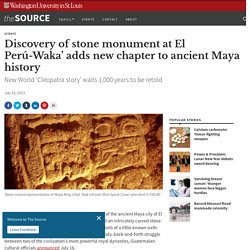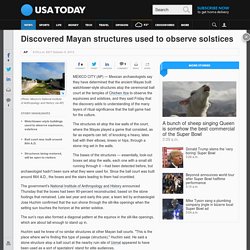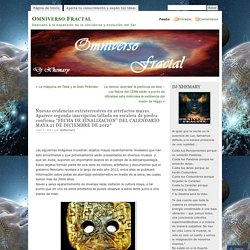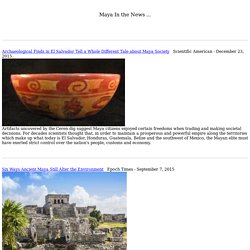

Extraterrestre le pide construir una pirámide en el desierto de Coahuila... ¡Y la construye! El mundo que habitaba Mundo se estaba desmoronando.

Muchos veían aparatos voladores en el cielo, pocos creían sobre la existencia de una aparición de otra galaxia que exigía una construcción de algo que ni siquiera conocían en el desierto norteño. A menudo preguntaban cómo se llamaba la aparición, quién era ese que hablaba del universo y sus estrellas. En una de tantas visitas, el extraterrestre agarró una piedra del suelo, con los dedos dibujó una forma parecida a una serpiente que no se quedó plasmada, y pidió descifrar sus trazos. En el momento que lograra comprender, sabría su nombre. Mundo sólo enseñaba la piedra a quien preguntara mayores detalles. Discovery of stone monument at El Perú-Waka’ adds new chapter to ancient Maya history.
Archaeologists tunneling beneath the main temple of the ancient Maya city of El Perú-Waka’ in northern Guatemala have discovered an intricately carved stone monument with hieroglyphic text detailing the exploits of a little-known sixth-century princess whose progeny prevailed in a bloody, back-and-forth struggle between two of the civilization’s most powerful royal dynasties, Guatemalan cultural officials announced July 16.

“Great rulers took pleasure in describing adversity as a prelude to ultimate success,” said research director David Freidel, PhD, a professor of anthropology in Arts & Sciences at Washington University in St. Louis. “Here the Snake queen, Lady Ikoom, prevailed in the end.” Freidel, who is studying in Paris this summer, said the stone monument, known officially as El Perú Stela 44, offers a wealth of new information about a “dark period” in Maya history, including the names of two previously unknown Maya rulers and the political realities that shaped their legacies. Discovered Mayan structures used to observe solstices. MEXICO CITY (AP) — Mexican archaeologists say they have determined that the ancient Mayas built watchtower-style structures atop the ceremonial ball court at the temples of Chichen Itza to observe the equinoxes and solstices, and they said Friday that the discovery adds to understanding of the many layers of ritual significance that the ball game had for the culture.

The structures sit atop the low walls of the court, where the Mayas played a game that consisted, as far as experts can tell, of knocking a heavy, latex ball with their elbows, knees or hips, through a stone ring set in the walls. The bases of the structures — essentially, look-out boxes set atop the walls, each one with a small slit running through it —had been detected before, but archaeologist hadn't been sure what they were used for.
Since the ball court was built around 864 A.D., the boxes and the stairs leading to them had crumbled. Huchim said he knew of no similar structures at other Mayan ball courts. Maya Gods and Kings, photo gallery. Maya Cosmological Creation. Maya Cosmological Creation Anthony Garone March, 2006 When constructing a Mayan home, a shaman is called upon to set the mathematical foundation from which it is built.

In addition to mathematical constructs, the center of each home contains a simple hearth. The hearth is composed of three stones in a triangular formation, which contain a fire at its center to both warm the home and cook meals. The significance of this hearth is twofold in that it also represents a place of creation set in the heavens by the Maya maize god, Hun-Nal-Yeh over 5000 years ago. Three stars in the constellation of Orion (Alnitak, Saiph and Rigel), form a triangle emanating from Alnitak (the belt star) surrounding the Orion nebulae which is the birth-place of stars. The Orion Nebulae - birthplace of stars Before we fix our eyes on the heavens, we need to look to the past and the mythology of the Maya people to fully appreciate the beautiful pageantry played out in the celestial sphere. Los Mayas y sus construcciones-Parte 1. Los Mayas: palacios y pirámides « Artehistoria. ¡Exclusiva mundial! encuentran artefactos alien en las Pirámides mayas y egipcias.
¡Exclusiva mundial!

Archaeologist Discovers Mysterious Ancient Maya Citadel. First uncovered through remote sensing, the jungle-shrouded complex has archaeologists both perplexed and amazed.

For three decades, archaeologist Anabel Ford has been exploring and studying the ancient Maya site of El Pilar, but until now she has never encountered anything like the ‘Citadel’. “We discovered a completely new component of the greater site that does not meet with any traditional expectations,” said Ford.
“It shares nothing in common with Classic Maya centers: no clear open plaza, no cardinal structure orientation, and curiously no evident relationship to the major Classic site of El Pilar, little more that 600 meters away. " Nuevas evidencias extraterrestres en artefactos mayas. Aparece segunda inscripción tallada en escalera de piedra confirma “FECHA DE FINALIZACION” DEL CALENDARIO MAYA 21 DE DICIEMBRE DE 2012″
Nuevas evidencias extraterrestres en artefactos mayas.

Aparece segunda inscripción tallada en escalera de piedra confirma “FECHA DE FINALIZACION” DEL CALENDARIO MAYA 21 DE DICIEMBRE DE 2012″ julio 1, 2012 por djxhemary. Chichén Itzá – a sacred city of the Maya. Chichén Itzá (pronounced “chee-CHEN eet-ZAH”) is the largest of the ruined Mayan cities on the Yucatán Peninsula and one of Mexico’s most-visited tourist destinations.

Construction began in the 7th century and the city reached its peak after the arrival of the Toltecs in the 10th century. Located 75 miles east of Merida, the capital of the State of Yucatan, Mexico; this archaeological site is rated among the most important of the Maya culture and covers an area of approximately six square miles where hundreds of buildings once stood. Now most are mounds but more than thirty may still be seen by tourists. History The ruins are divided into two groups. One group belongs to the classic Maya Period and was built between the 7th and 10th centuries A.D., at which time the city became a prominent ceremonial center. When Chichen-Itza was first settled it was largely agricultural. Photo by: Chichén Itzá can also be reached by bus. Datos sobre las pirámides mayas.
Las pirámides mayas se destacan como uno de los logros arquitectónicos más impresionantes del mundo antiguo.

Diseñadas con precisión y requiriendo un enorme esfuerzo humano para su construcción, cuentan la historia de una sociedad altamente organizada, con logros únicos en el lenguaje, la astronomía y las matemáticas. Al mismo tiempo, las representaciones en las paredes del templo de los sacrificios humanos y ritos de sangre horripilantes cuentan una historia más oscura de una jerarquía brutal y una opresión violenta. Historia. Maya In the News ... Maya In the News ...

Archaeological Finds in El Salvador Tell a Whole Different Tale about Maya Society Scientific American - December 23, 2015 Artifacts uncovered by the Ceren dig suggest Maya citizens enjoyed certain freedoms when trading and making societal decisions. Mayan Art and Architecture. Mayan Art and Architecture As unique and spectacular as any Greek or Roman architecture, Maya architecture spans many thousands of years; yet, often the most dramatic and easily recognizable as Maya are the fantastic stepped pyramids from the Terminal Pre-classic period and beyond. Being based on the general Mesoamerican architectural traditions these pyramids relied on intricate carved stone in order to create a stair-step design. Each pyramid was dedicated to a deity whose shrine sat at its peak. Arquitectura Maya. MayanArchitectureSummary. Los Mayas: palacios y pirámides « Artehistoria. Ago art47. Mayas autenticos. Arquitectura maya. Las características principales de la arquitectura maya es la forma de techar, conocida como bóveda maya o arco falso.
Los edificios más comunes son: las pirámides (superposición de plataformas tronco piramidales), la cual sirve de basamento a los templos, los cuales suelen tener un elemento decorativo llamado crestería, que se sitúa en el techo y le añade altura al edificio. Diseño urbano[editar] List of Mesoamerican pyramids. This is a list of Mesoamerican pyramids or ceremonial structures. In most cases they are not true pyramids. There are hundreds of these done in many different styles throughout Mexico and Central America. Cultura maya. La cultura maya, con una historia de aproximadamente tres mil años, habitó en una parte de la región denominada Mesoamérica, en los territorios actuales de Guatemala, Belice, Honduras, El Salvador y en el territorio comprendido por cinco estados del sureste de México: Campeche, Chiapas, Quintana Roo, Tabasco y Yucatán.
La civilización maya se ha dividido en tres amplios períodos principales: el Preclásico, el Clásico y el Posclásico, los cuales fueron precedidos por el Período Arcaico, en el que los primeros pueblos se asentaron y se desarrolló la evolución inicial de la agricultura.[2] Durante ese largo tiempo desarrollaron una de las culturas mesoamericanas precolombinas más importantes.
En esos territorios se hablaron decenas de dialectos que dieron lugar a las 44 lenguas mayas modernas. La literatura maya ilustra la vida de esta cultura. Obras como el Rabinal Achí, el Popol Vuh, los diversos libros del Chilam Balam, son muestra de ello. Cultura maya.